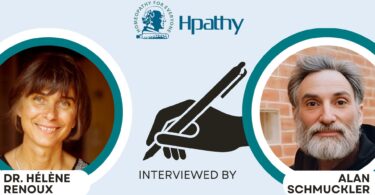C Foss trained at the Welsh School of Homeopathy in 2006 and graduated as a licentiate in 2010. She works at Women’s Aid for Project Sol, a registered charity that provides free or low cost homeopathic treatment to the under-waged or socially disadvantaged of the Swansea area, as well as at her private practice. Whilst a fourth year student she proved the remedy, Erinaceus Europaeus. She lives and works in rural Wales.
When did you graduate from The Welsh School of Homeopathy?
I graduated in July 2010.
Did you do the proving of Erinaceus when you were a student?
Yes, I did it in November 2009 in my 4th year. The dream proving was conducted one week later by Linda Gwillim at Winter School. I never intended to do a dream proving, but the scheduled lecturer dropped out at the last minute and Linda had to fill in. She asked me for some sachets of the powder and did the weekend on provings. It turned out to be a very intense weekend.
You were intrigued by hedgehog featuring so strongly in Chocolate which led you to proving Erinaceus but had you been interested in doing a proving before this?
A student before me had triturated Crab Apple and after hearing accounts by one or two of her triturators I thought I’d like to give it a try. I liked the fact that a trituration would ‘be over’ in one day (although that wasn’t the case) and was fascinated by the process of gaining information from just the grinding and scraping. It wasn’t until we started to get frequent visits by a hedgehog to our garden that I started to feel drawn to it as a possible remedy. Funnily we never get visits from hedgehogs now.
Usually remedies are made from the powder from the C3 stage. You chose to take your trituration up to the C4 stage. Why?
Purely as an experiment, to try something new and to explore the whole C4 homeopathy theory. I knew nothing about C4 homeopathy until I came across it while studying how to do a trituration. I found it fascinating. The Trituration Handbook by Anneke Hodeland and Judy Schriebman was my bible.
When doing the trituration you decided not to take it past the C4, why didn’t you take it up to C8?
For practical reasons really. By the end of C4 all my triturators had had enough and wanted to go home, curl up in bed and go to sleep! I think the number of stages you take the trituration to depends on the substance. Some will call for more, some may call for less. I had wanted to take the remedy further so I decided to make up my own medicating potency by hand to a 40c (or in C4 homeopathy language, a ‘C40/4’) after the trituration was over. Once I had done this, I felt it had reached a natural end.
It is said that C4 works on the spiritual level whilst C1 works on the vital body, C2 on the emotional body, C3 on the mental body, have you found this to be true?
I found it difficult to feel these stages clearly while triturating but when I collated all the information from the triturators notebooks, although there were overlaps, the distinctions between the levels were quite clearly there. Since triturating Erinaceus I have taken part in two more triturations: Lana by Della Green and Tabacum by Petra Wood. I think triturations are a fantastic way of gaining first hand experience of a remedy and one of the best ways to learn.
From the C4 powder Erinaceus was made into medicating potency. You have a case that you have published where you use C40/4 (taken from the C4 powder, equivalent to 30c when taken from the C3 powder). Has it been taken to a higher potency?
As far as I know, Helios stock 30c, 200c and 1M made from the C4 powder rather than the C3. If you want to use the ‘proper’ C4 potencies i.e – C40/4, C220/4 and C1300/4, you have to order them specially. I have read about homeopaths who claim that potencies made from the C4 powder better enable their clients to look beyond their old patterns. I think it is a really interesting slant on potencies and well worth looking into further.
What was the essence of Erinaceus?
Hedgehogs have a psychological condition named after them known as the ‘hedgehog’s dilemma’ which describes the struggle they feel when trying to get close enough for comfort and warmth while trying not to get pricked. It describes people who shun intimate relationships due to past hurtful experiences.
By Romany tradition, hedgehogs were eaten as a blood cleanser, the liver being the ultimate purifier for lying and deceit. Along this theme, a great deal of guilt came through in the proving, mainly to do with children and babies. There was also a theme of inherited shame and ‘skeletons in the family closet’.
On a physical level there is a desire to curl up and go to sleep with very droopy eyes but feeling a duty to endure and keep going. There are also throat symptoms and a great deal of night-time restlessness. The triturartors could barely stay awake, while all the dream provers, bar one, tossed and turned all night. One prover came down with tonsillitis after the proving and was given the remedy Chocolate, which cleared it up.
The proving of Erinaceus is currently being updated. If you would like more details, please contact Chloe on [email protected]
Would you like to do another proving?
I would like to do another proving but have no idea what or when that will be. At the moment I am putting my energy into building my private practice and running clinics at Women’s Aid and Mind.
I am intrigued by the C4 potencies and the potential of C5 to C8 do you think this is an area to be explored?
Yes I think this is a fascinating area to be explored and something I would be interested in participating in. Witold Ehrler devised the theory of levels up to C8 and this is explained in the Trituration Handbook. On a practical level though, going up to C8 would take the best part of two days and would depend on the enthusiasm of your group and the energy of the substance. I think it is important not to go into triturations expecting too much, and just see where the remedy takes you.
Since graduating two years ago what has been the most challenging situation?
Working at Women’s Aid has thrown up several challenging situations that have made me think really seriously about how I practice. The women there are working through very deep issues, suffering with conditions such as suicidal depression, insomnia, chronic anxiety and pain.
What have been the most rewarding moments of working as a homeopath so far?
Since Women’s Aid started to pay me I feel I am a valued member of the team. I was delighted to be asked to write a report for their AGM and to be invited to their audit recently.
I am sure that new graduates would be interested in knowing what have you found to be most successful in promoting your practice?
Building my website helped to promote my business. It took a long time, but I really enjoyed the creative side of it. My voluntary work has meant referrals from clients and staff and helped things get off the ground. I also make good use of Facebook and find it very useful for networking and sharing ideas with other homeopaths and I have picked up a few new clients there too.
What advice would you give to new graduates?
I would say volunteer some of your time to keep yourself feeling busy as a homeopath. After a while of this my practice did start to grow. It gives you experience and builds your confidence. When you are confident in your own abilities you naturally attract more clients. Do the voluntary work with an open heart and you’ll get paid in other ways. Sounds cheesy, but it works for me!
What is the best thing about being a homeopath?
I think it is having the tools to respond effectively in a crisis for both myself and my family. My love for homeopathy began with my children. It has always been my first port of call whenever anything goes wrong.
http://www.llandeilohomeopath.co.uk/







Dear Sir /Madam,
This interview interested and I get more knowledge about homeopathy.
Thanks
Dr. Vikas Jaiswal